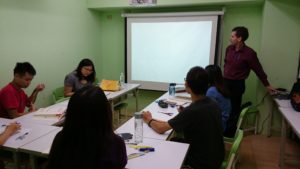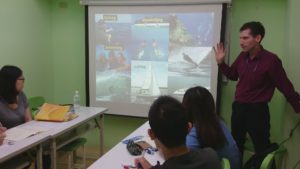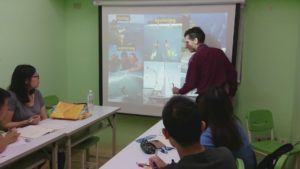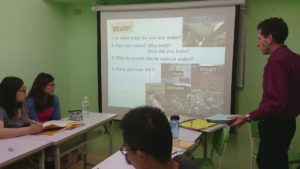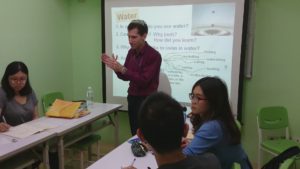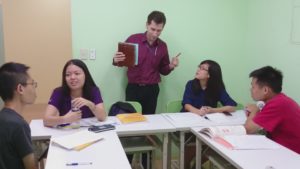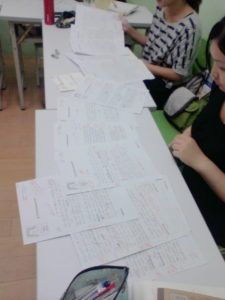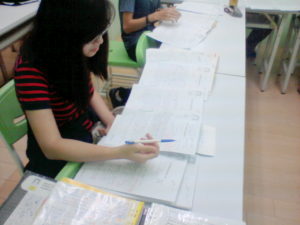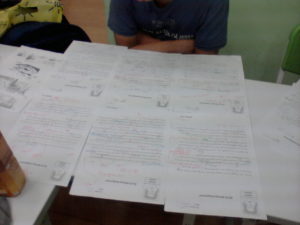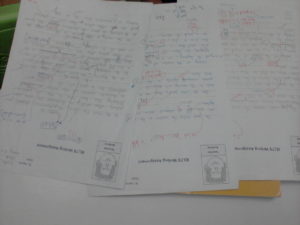Background and Method
I am a Cambridge-accredited CELTA tutor (ESL teacher trainer), so I certainly know a lot about methods. The method I use is known as Communicative Language Teaching (CLT), which basically means that the teaching should involve …
- communication (by raising students’ talking time; lowering the teacher’s talking time, and with an emphasis on ‘doing’ rather than ‘explaining’).
- tasks – for example, by filling in a table, reading or listening to a text with comprehension questions, or finding out three facts about your partner.
- meaningful use of language – for example, by placing communication in context; use of personalisation [talking about yourself]; real pronunciation (with sentence stress, weak forms, use of phonemics).
- student-centredness – such as in the elicitation of language and vocabulary, group work, correction codes with written work, and interactive activities.
- reducing emotional filters – meaning making the teaching enjoyable for all; reducing stress; using theatrics and humour.
Do not think that a ‘Reading’ course involves only reading, or a ‘Writing’ course involves only writing. Many of my ‘writing’ students, upon doing the IELTS test, receive higher speaking bandscores! Yes, whether it’s listening, reading, or writing, there will be lots of speaking involved – for example, in Writing Task Two, I usually begin with a brainstorming on two issues, with information exchange activities, sometimes based on homework research.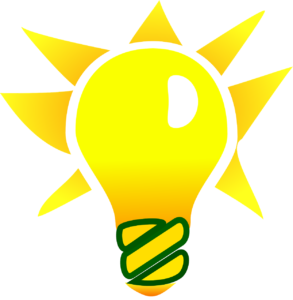
Here’s one final note. My classroom is particularly different from others in the use of PowerPoint Programs, which I have been extensively creating and adapting in order to teach more effectively (by following the previous five principles), and with maximum efficiency. I barely use the whiteboard now: everything has been planned and programmed into the PowerPoints, and I keep making them better and better and better. I now claim (confidently) to have the world’s most sophisticated PowerPoints – and they are all focused on teaching English and IELTS skills.
A Typical Speaking Activity
Here are the stages in a typical Speaking Activity.
Amount of Writing
There is LOTS of writing in the Writing Classes. Writing homework is given in every class, apart from the first Writing Task Two class, and the final classes (since I cannot correct homework given inthe last class). All together, that is …
- four Writing Task Two’s (in six classes),
- five Writing Task One’s (in six classes).
… making nine pieces of writing in the IELTS Writing (& Listening) Course. More importantly, …
- all writing assignments are given back the next writing lesson,
- the writing is very carefully corrected, and I am famous for my thoroughness and attention to detail, using error codes, page references to the IELTS course books [my own], and comments,
- there is a feedback session in every writing class, where students self-correct their writing, compare with other students, ask me questions, and receive the benefit of my …
- IELTS Grammar,
- IELTS Writing Appropriacy,
- IELTS Writing Task One,
- IELTS Writing Task Two,
… PowerPoints, which (with their 10 years of development) begin their efficient and effective teaching.

This is just ONE of the crrected writing answers.
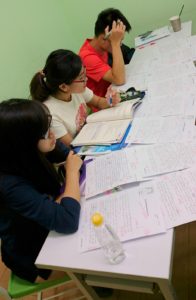
That last W2 lesson again; reviewing everything I have taught. Click on the picture to see how carefully and thoroughly every writing is corrected.
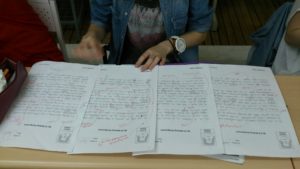
Each student has four corrected Writing Task Twos.
… and all the writings (Task One’s in this picture) are meticulously corrected. Click on the pictures to have a look.
Homework
Check the picture at the top of this page. Every lesson (Listening, Reading, Writing One, Writing Two, or Speaking) finishes with the ‘Homework Slide’, which clearly outlines the homework. This homework may include …
- looking and reading specific tips from the IELTS coursebook (with their associated exercises),
- an IELTS writing assignment,
- research and note taking.
I hope to see you in my classroom one day.

